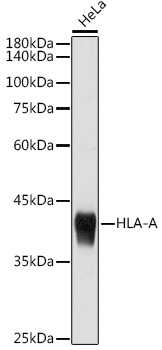HLA-A antibody [N1C2]
GTX114080
ApplicationsImmunoPrecipitation, Western Blot, ImmunoHistoChemistry, ImmunoHistoChemistry Paraffin
Product group Antibodies
TargetHLA-A
Overview
- SupplierGeneTex
- Product NameHLA-A antibody [N1C2]
- Delivery Days Customer9
- Application Supplier NoteWB: 1:500-1:3000. IP: 1:100-1:500. *Optimal dilutions/concentrations should be determined by the researcher.Not tested in other applications.
- ApplicationsImmunoPrecipitation, Western Blot, ImmunoHistoChemistry, ImmunoHistoChemistry Paraffin
- CertificationResearch Use Only
- ClonalityPolyclonal
- Concentration0.76 mg/ml
- ConjugateUnconjugated
- Gene ID3105
- Target nameHLA-A
- Target descriptionmajor histocompatibility complex, class I, A
- Target synonymsHLAA, HLA class I histocompatibility antigen, A alpha chain, HLA class I histocompatibility antigen, A-1 alpha chain, MHC class I antigen HLA-A heavy chain, leukocyte antigen class I-A
- HostRabbit
- IsotypeIgG
- Protein IDP04439
- Protein NameHLA class I histocompatibility antigen, A alpha chain
- Scientific DescriptionHLA-A belongs to the HLA class I heavy chain paralogues. This class I molecule is a heterodimer consisting of a heavy chain and a light chain (beta-2 microglobulin). The heavy chain is anchored in the membrane. Class I molecules play a central role in the immune system by presenting peptides derived from the endoplasmic reticulum lumen. They are expressed in nearly all cells. The heavy chain is approximately 45 kDa and its gene contains 8 exons. Exon 1 encodes the leader peptide, exons 2 and 3 encode the alpha1 and alpha2 domains, which both bind the peptide, exon 4 encodes the alpha3 domain, exon 5 encodes the transmembrane region, and exons 6 and 7 encode the cytoplasmic tail. Polymorphisms within exon 2 and exon 3 are responsible for the peptide binding specificity of each class one molecule. Typing for these polymorphisms is routinely done for bone marrow and kidney transplantation. Hundreds of HLA-A alleles have been described. [provided by RefSeq, Jul 2008]
- Storage Instruction-20°C or -80°C,2°C to 8°C
- UNSPSC12352203
References
- Sher AA, Lao YT, Coombs KM. HLA-A, HSPA5, IGFBP5 and PSMA2 Are Restriction Factors for Zika Virus Growth in Astrocytic Cells. Viruses. 2022,15(1). doi: 10.3390/v15010097Read this paper
- Rashid MU, Glover KKM, Lao Y, et al. Temporal proteomic analyses of human lung cells distinguish high pathogenicity influenza viruses and coronaviruses from low pathogenicity viruses. Front Microbiol. 2022,13:994512. doi: 10.3389/fmicb.2022.994512Read this paper





